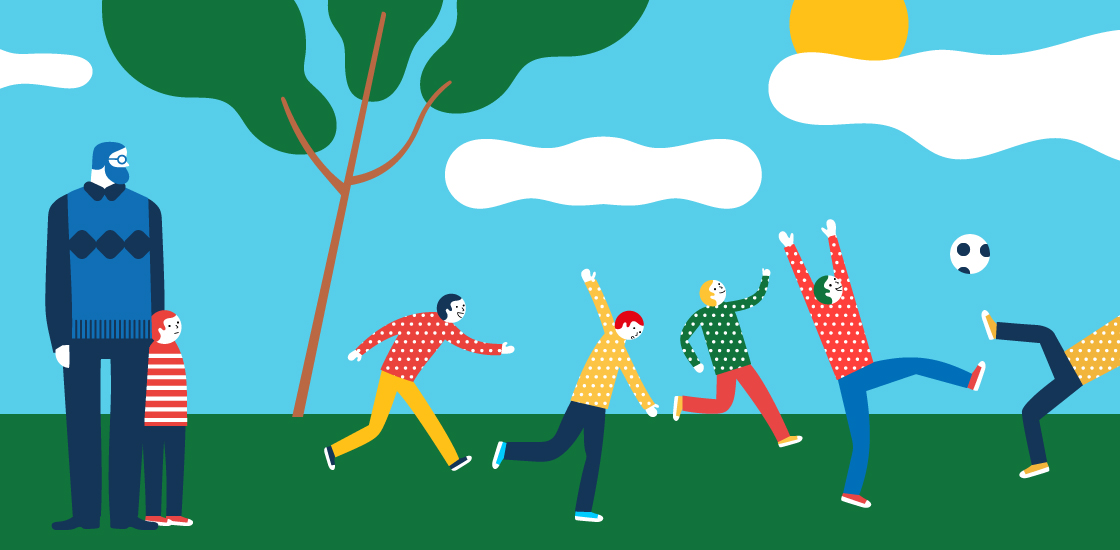THIS ARTICLE IS MORE THAN FIVE YEARS OLD
This article is more than five years old. Autism research — and science in general — is constantly evolving, so older articles may contain information or theories that have been reevaluated since their original publication date.

Listen to this story:
Evan stands close to a teacher who is supervising recess while the other children play. Sometimes Evan paces back and forth, flaps his hands and recites lines from the television show “SpongeBob SquarePants” to himself. Other times, he pretends that he is a ninja fighting an imaginary adversary, or repeatedly asks the teacher when it will be time to go back inside. (I have left out Evan’s last name to protect his privacy.)
Occasionally he stops to look around at his peers, who are playing soccer, chatting, swinging, shooting baskets or chasing each other on the playground. A 10-year-old with autism, he simply does not know how to approach or interact with his peers. To him, it seems like all of them naturally know how to talk and play with one another.
Evan feels much more comfortable in the classroom, where there is explicit structure and clear expectations. By contrast, recess is an unstructured jungle where Evan is not quite sure what he should be doing.
Evan’s peers would never suspect that, if asked, he would tell them how much he really wants to play with them. Sometimes they look over at Evan and seem puzzled and confused by his behavior. No one is unkind to Evan, because no one interacts with him at all. Perplexed about why he would choose to play by himself and stand by the teacher, they keep their distance.
The teacher who supervises recess is sad that Evan stands close to her and plays by himself instead of with his peers. She wishes that he had the skills to join his peers, and that his peers would include him in their play.
Many students with autism struggle to play with their peers in unstructured situations or to develop friendships with children who do not have disabilities1. Although teachers are often sympathetic to these challenges, they rarely feel empowered to help.
Peer support:
My colleagues and I are tackling this problem by developing strategies for supporting students with autism during recess.
We still have a lot of work to do, but our preliminary findings indicate that coaching peers to play with students who have autism is a promising avenue. And the teachers and paraprofessionals who supervise recess could implement this approach after brief training from our research team.
In a pilot study published last year, we randomly divided 11 elementary and middle school students with autism from six schools into two groups2. For one group of five students, we observed recess but did not intervene. For the other group of six students (which included Evan), we trained teachers and paraprofessionals who were supervising recess to facilitate a four-step intervention.
First, the teacher wrote down information about the student with autism that would be important to share with the student’s peers. This included a description of what the student usually did during recess, specific goals for improving his play and social interaction, and a list of play activities the student might enjoy if invited by peers.
The typical children also received tips for how they might best communicate with that student, and descriptions of any unusual behavior or special interest that might initially be confusing to them.
Second, the teacher identified two to four peers who might be willing to support and play with the student with autism during recess. We encouraged teachers to invite peers who followed adult directions well, modeled positive communication and social skills, and were typically present at school. If a teacher had already seen a peer positively interacting with the student in the classroom or at lunch, that child might be a great choice.
The teachers then met with the peers during lunch. At this meeting, the teacher shared the information she had written down, and taught the peers five strategies associated with pivotal response training, an approach that involves behavioral strategies designed to be naturally engaging and motivating3. The teacher taught the peers five strategies: Get your buddy to look at you; ask your buddy to play something with you; show and talk about how you play; compliment your buddy; and if you can’t play at the same time, help your buddy to take turns.
The teachers modeled these strategies and helped the typical students practice them through role play. They also provided ongoing support to the peers during recess by helping them to set goals for how they would support the student and providing prompts and encouragement when needed.
Promising results:
This intervention produced a striking improvement in social outcomes for the students with autism.
The students with autism who participated interacted with their peers more than three times as often and played with peers nearly four times as often as those who did not get the help. The teachers told us that implementing this approach was not difficult, and that they planned to help more students.
Our findings are exciting and encouraging. We learned that school staff can feasibly facilitate a peer-mediated intervention during recess. The study was limited in scope, however. It comprised mostly white male students with autism in six suburban schools.
We need to replicate our findings with larger and more diverse samples before we can be certain that the approach would help other students with autism. We’d also like to test the strategy with students who have social problems not associated with autism. Some students without a diagnosis of autism might also struggle to interact appropriately with peers, understand the rules of different recess games and build new friendships. We think our approach might help these students, too.
After participating in our study, Evan substantially increased his interactions with the other students during recess. He also engaged in new activities. Evan’s peers were excited and surprised to learn that he was an excellent soccer player. When we asked Evan what he thought of his new friends, he said, “Sometimes I was alone and didn’t know who to play with, and they would come up to me and ask me to play.”
Matthew Brock is assistant professor of special education at Ohio State University.
